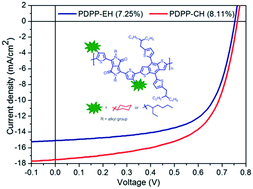A diketopyrrolopyrrole-based low bandgap polymer with enhanced photovoltaic performances through backbone twisting†
Abstract
A diketopyrrolopyrrole (DPP)-based π-conjugated polymer is a very promising low band gap electron donor material for polymer solar cells. We have incorporated alkyl groups into the 4-position of the thiophene rings connected to the DPP fragment, which is proven to be beneficial for improving the open-circuit voltage (VOC) and short-circuit current density (JSC). Two DPP-based polymers are synthesized with benzo[1,2-b:4,5-b′]dithiophene (BDT) as the electron-donating segment. Both the polymers show good solubility, slightly wide optical band gaps and deep HOMO energy levels when incorporating the alkyl groups. Heterojunction solar cells are fabricated with polymer:PC71BM as the active layer. VOC and JSC are simultaneously enhanced compared to the device performance of traditional DPP-BDT alternating polymers. A power conversion efficiency (PCE) of 8.11% was obtained, which indicates that rational utilization of backbone torsion is a promising strategy to improve the photovoltaic performance.

- This article is part of the themed collection: 2016 Journal of Materials Chemistry A HOT Papers

 Please wait while we load your content...
Please wait while we load your content...